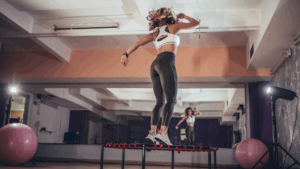
Dreaming of a sculpted hourglass figure without hitting the gym? With our targeted back workout, you can achieve those enviable curves from the comfort of your home. Are you ready to transform your physique and boost your confidence? This blog post is your ultimate guide to an effective hourglass back workout regimen that delivers results. No fancy equipment or expensive memberships required – just determination and consistency.
Get ready to unleash your potential with these simple yet powerful exercises designed to tone and shape your back, bringing you closer to that coveted hourglass silhouette.
To achieve the coveted hourglass figure, it’s crucial to focus on both the upper and lower back muscles. Working on these areas helps create a balanced physique with a defined waistline. Exercises like lat pulldowns, seated rows, and hyperextensions are great for engaging the entire back, ensuring that no muscle group is left behind.
When you target your upper back, you engage muscles such as the trapezius, rhomboids, and rear deltoids. These exercises not only contribute to overall strength but also play a significant role in achieving that desirable V-shape taper from shoulders to waist.
Conversely, focusing on the lower back involves strengthening muscles like the erector spinae. This adds depth to your silhouette while providing essential support for good posture.
While consistent training is vital for progress, it’s equally important to allow ample time for rest and recovery. Overtraining can lead to fatigue or even injury, hindering your journey towards an hourglass figure.
To strike this balance effectively:
The close grip assisted pull-up is an excellent exercise for sculpting the upper back. It specifically targets the muscles in this area, helping to create a defined and toned look. By engaging in this workout, you can effectively work on achieving that coveted hourglass figure.
When performing close grip assisted pull-ups, you primarily engage your latissimus dorsi, which are the largest muscles in your upper body. This exercise also works your biceps and forearms, contributing to a well-rounded upper body workout.
Using assistance bands with close grip pull-ups allows individuals to gradually increase their strength over time. These bands provide support as you perform the exercise, making it more accessible for those who may struggle with traditional pull-ups. As one’s strength improves, they can transition to lighter resistance bands or eventually perform unassisted close grip pull-ups.
Resistance bands are versatile and convenient tools for back workouts at home. They offer several advantages, such as being affordable, portable, and suitable for all fitness levels. Unlike traditional weights, resistance bands provide continuous tension throughout the entire range of motion, making the exercises more effective.
Using resistance bands allows you to engage multiple muscle groups simultaneously while performing wide grip lat pulldown variations. This helps in developing overall back strength and stability. Furthermore, the constant tension provided by the bands can enhance muscle endurance and promote better muscle activation during each repetition.
One benefit of using resistance bands for wide grip lat pulldown alternatives is the ability to target specific areas of the back. By adjusting your hand position or anchoring point when using the bands, you can emphasize different parts of your back muscles. For instance, a higher anchor point will engage more of your upper back muscles while a lower anchor point will focus on your lower lats.
You can also vary your grip width on the resistance band to shift emphasis from one part of your back to another. A wider grip targets the outer portion of your lats while a narrower grip places more emphasis on the inner portion.
Replicating a seated cable row workout at home is easier than you might think. You can achieve similar results by using household items as makeshift equipment. For instance, you can use a sturdy door anchor and resistance bands to mimic the pulling motion of a seated cable row. Simply secure the door anchor at the right height, loop the resistance bands through it, and pull them towards your body, just like you would with a cable machine.
You can also get creative with everyday objects such as water jugs or milk cartons filled with sand or water to add resistance. Hold one in each hand and perform rows while maintaining proper form for an effective back workout. By improvising with these household items, you can effectively target your back muscles without needing expensive gym equipment.
Another option is utilizing a sturdy table and a bedsheet or towel. Loop the sheet around the table legs, hold each end of the sheet in your hands, sit back slightly, then pull yourself forward using your back muscles against the resistance of the sheet.
When performing seated rows at home using makeshift equipment, it’s crucial to maintain proper posture throughout each repetition. Keep your back straight, shoulders down and relaxed, and engage your core muscles to avoid straining your lower back.
Lateral arm raises are an effective way to engage the muscles of the upper back and shoulders. When performing this exercise, you primarily activate the deltoid muscles, which are located in your shoulders. As you lift your arms out to the sides, you engage the trapezius muscles in your upper back. This movement helps improve posture and overall upper body strength.
This exercise is particularly beneficial for individuals looking to enhance their back definition. By targeting these specific muscle groups, lateral arm raises contribute to a more sculpted and defined appearance in the back area. The controlled motion of lifting weights outwards not only strengthens these muscles but also promotes better stability and balance in everyday activities.
To target different muscle groups within the upper back and shoulders, there are variations of lateral arm raises that can be incorporated into your workout routine. For example, using dumbbells instead of resistance bands can add more resistance for a greater challenge. You can also try bent-over lateral raises by bending at the waist while keeping your back straight; this targets slightly different areas of the upper back compared to standing lateral raises.
Incorporating proper breathing techniques during lateral arm raises is crucial for optimal results. Remember to exhale as you lift your arms up and inhale as you lower them down. This coordinated breathing pattern helps stabilize your core while engaging specific muscle groups effectively.
Alternating dumbbell presses are an excellent choice for hourglass back workout at home because they engage both sides of the back equally. This exercise helps in achieving a balanced and symmetrical back shape. By working each side independently, it prevents muscle imbalances and ensures that one side doesn’t become stronger or more developed than the other.
Alternating dumbbell presses also promote overall back development, targeting various muscles including the latissimus dorsi, trapezius, rhomboids, and rear deltoids. This results in improved posture, enhanced strength, and better stability in daily activities.
When incorporating alternating dumbbell presses into your home workout routine, it’s crucial to choose weights that challenge you without compromising proper form. Start with lighter weights if you’re new to this exercise and gradually increase as you get stronger. Aim for 2-3 sets of 10-12 repetitions per arm to effectively work on building a well-rounded back shape.
It’s essential to listen to your body during the workout sessions to avoid overexertion or injury. Pay attention to any discomfort or strain while performing the exercise and adjust the weight or repetition range accordingly.
A strong core is crucial for supporting back strength. When your core muscles are weak, it puts extra strain on your back, leading to potential injuries. By incorporating exercises that target the core, such as planks, Russian twists, or bicycle crunches into your hourglass back workout at home, you can improve overall stability and reduce the risk of back pain.
By engaging in core-focused movements, you’re not only strengthening the abdominal muscles but also providing essential support to your spine. This helps maintain proper posture during other exercises targeting the back muscles while minimizing the risk of strain or injury.
To create a comprehensive workout routine for an hourglass back shape, consider integrating kickboxing elements with traditional core exercises. For example, combining punches and kicks with standing ab twists or knee raises can elevate heart rate while engaging both the core and back muscles simultaneously.
Kickboxing movements involve rotational actions which engage multiple muscle groups including those in the abdomen and lower back. These dynamic moves help develop functional strength by mimicking real-life activities where different muscle groups work together to perform tasks.
Incorporating these elements not only strengthens your back muscles but also enhances overall body coordination through a combination of cardio-based kickboxing workouts and targeted core exercises.
Hip thrusts and bridges are excellent exercises for targeting the lower back and glutes simultaneously. When performing hip thrusts, you lie on your back with your knees bent, then raise your hips off the ground. This movement engages the muscles in your lower back and glutes, helping to strengthen these areas.
These exercises also work wonders for enhancing the shape of your glutes. As you lift your hips off the ground, it activates the glute muscles, contributing to a firmer and more defined appearance over time.
To increase difficulty over time, you can add resistance by using barbells or resistance bands during hip thrusts. Incorporating single-leg variations of these exercises can further challenge both your lower back and glutes.
Gradually increasing the number of repetitions or sets as you build strength is another effective way to progress with these workouts. By challenging yourself in this manner, you’ll see noticeable improvements in both muscle tone and strength in your lower back and glutes.
Engaging the core during hip thrusts and bridges is crucial for maintaining proper form while performing these exercises. A strong core not only supports your spine but also helps stabilize movements that target other muscle groups such as the lower back and glutes.
Remember to keep your abdominal muscles tight throughout each repetition to ensure that they actively contribute to stabilizing the body during these exercises.
Lateral lunges are an excellent way to engage multiple muscles in the back. When performing lateral lunges, not only do you work your glutes and quadriceps, but you also activate the latissimus dorsi, which is the broad muscle of the back. This comprehensive engagement helps in strengthening and toning various areas of your back simultaneously.
Lateral lunges can be modified to target different areas of the back. By adding a twist or rotation at the bottom of each lunge, you can engage more muscles along your entire back, including the lower and upper regions. These variations allow for a more thorough workout that targets specific trouble spots on your back.
Incorporating proper form and balance into your lateral lunges is crucial for effective results. It’s essential to keep your chest lifted, shoulders relaxed, and spine neutral throughout each lunge to ensure that you are effectively targeting your back muscles without straining other parts of your body. Maintaining balance during lateral lunges helps in stabilizing and strengthening core muscles while working on improving posture.
When performing these exercises at home, it’s important to remember that executing each movement correctly is more beneficial than doing many repetitions with poor form. Taking time to understand how to properly perform lateral lunges will maximize their effectiveness in strengthening various back muscles.
Congratulations on making it through the essentials of an effective hourglass back routine!
You’ve learned about various exercises and adaptations that can help you sculpt and strengthen your back muscles right at home. Now, armed with these alternative workouts, you’re ready to take your fitness journey to the next level.
So, what are you waiting for? It’s time to put these exercises into action and start building the strong, defined back you’ve always wanted. Remember, consistency is key, so make these exercises a regular part of your routine.
To effectively sculpt your back at home, focus on exercises such as close grip assisted pull-ups, wide grip lat pulldown alternatives with resistance bands, and seated cable row adaptations. Incorporating these exercises into your routine will help you achieve a well-defined and strong back.
Incorporating hip thrusts and bridges into your workout routine is an effective way to enhance lower back and glute muscles. These exercises target the posterior chain, helping to build strength and definition in these areas.
Yes, incorporating core-strengthening exercises such as lateral lunges can complement your efforts to strengthen your back muscles. By engaging both the core and the back simultaneously, you can achieve comprehensive muscle strengthening for a balanced physique.
Certainly! You can use resistance bands as alternatives to traditional gym equipment for working out the upper back. For instance, utilizing resistance bands in wide grip lat pulldown variations can effectively target the upper back muscles.
Incorporating kickboxing elements not only adds variety but also helps improve overall strength by engaging multiple muscle groups simultaneously. It provides an enjoyable way of enhancing cardiovascular health while contributing to improved muscular endurance in the context of building a strong and defined back.

Enjoy cozy comfort food with this Homestyle Chicken and Dumplings recipe. Packed with tender chicken, veggies, and fluffy dumplings in a savory broth—perfect for family dinners and cold nights.

Learn how setting boundaries and saying no is a powerful act of self-care for women. Discover how to protect your energy, honor your needs, and build confidence through boundary-setting.

Enjoy a gourmet twist on a classic Italian favorite with this Caprese Panini with Pesto. Perfectly grilled sourdough, fresh mozzarella, tomatoes, and basil pesto make it an easy, healthy vegetarian lunch idea.

Learn why breaking the stigma around depression and therapy is essential for women. Discover how to talk openly about mental health and seek support without shame.

This Creamy Tuscan Sun-Dried Tomato Pasta combines garlic-Parmesan sauce, spinach, and sun-dried tomatoes for a rich, comforting meal you can make in 30 minutes. Perfect for date night or a cozy dinner at home.

Discover low-impact workouts for women designed to help you lose weight gently and safely. Perfect for beginners, busy moms, or anyone easing back into fitness.